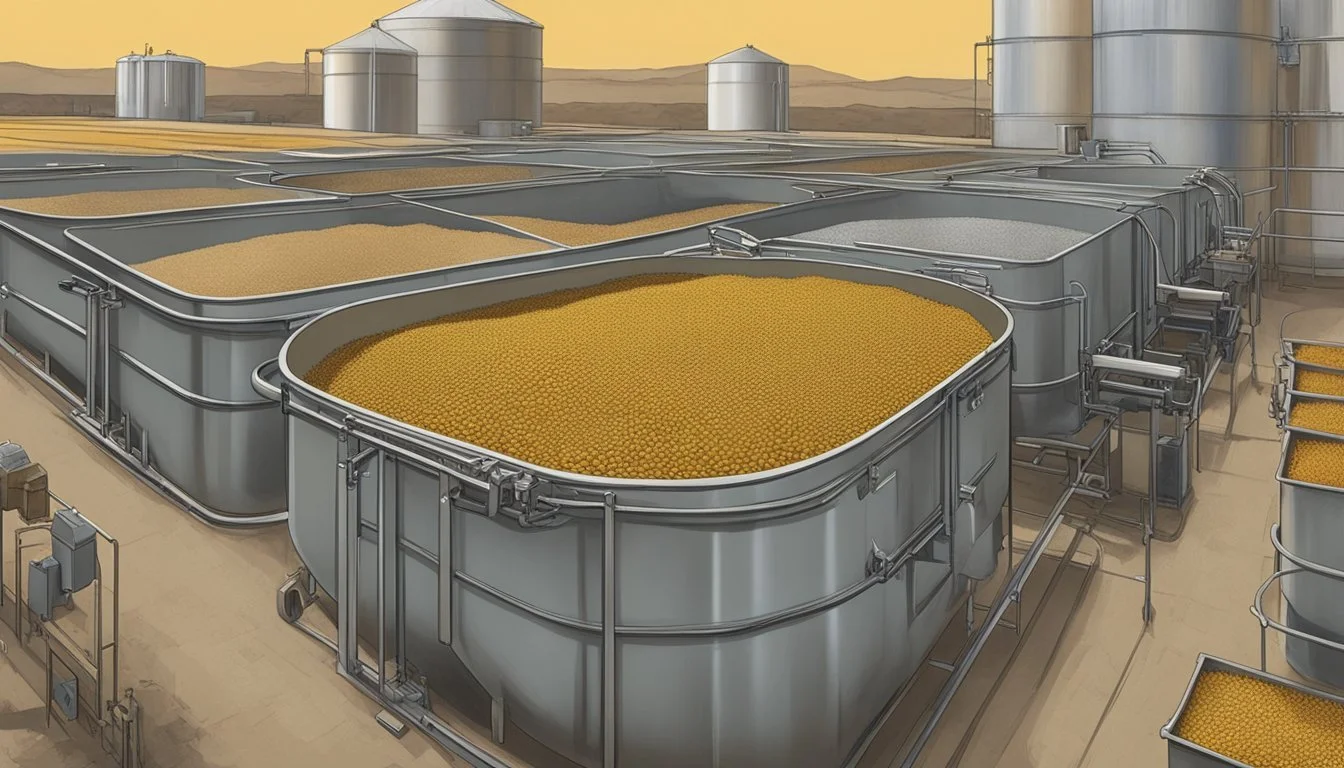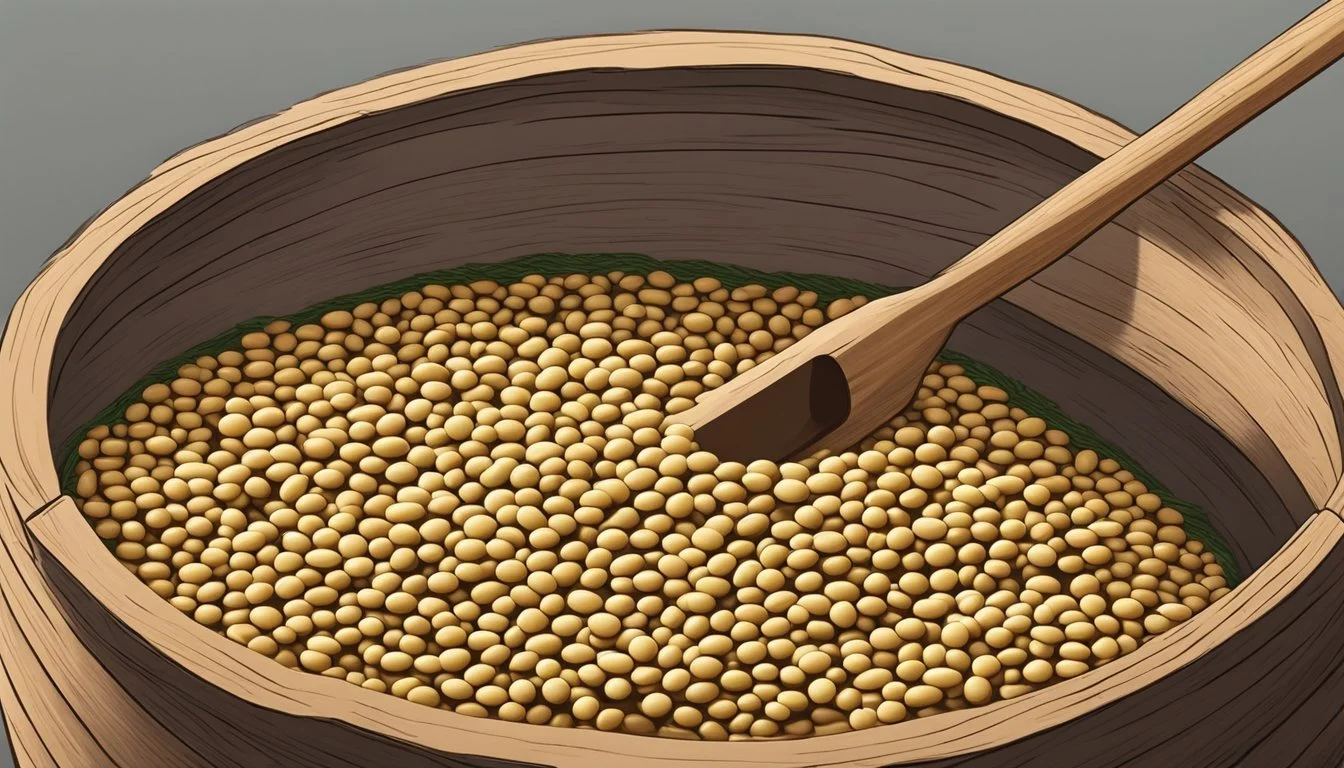How to Ferment Soy Sauce
Mastering Traditional Techniques
Soy sauce is a staple condiment with deep roots in Asian cuisine, enjoyed worldwide for its rich, umami flavor. The process of making soy sauce involves fermentation, a method that has been refined over centuries. This traditional condiment is typically made from a mixture of soybeans and grains, such as wheat, that undergo a transformative process facilitated by microorganisms. The art of fermenting soy sauce at home can be a rewarding experience, allowing individuals to craft a version tailored to personal taste preferences, ranging from sweet and light to dark and robust.
In crafting homemade soy sauce, the process begins by combining cooked soybeans with roasted, ground grains to create a base. This base is then inoculated with a type of mold known as koji, which initiates the fermentation process. As the koji works its magic, it breaks down the starches and proteins in the soybean and grain mixture, a key step in developing the complex flavors characteristic of soy sauce. What follows is a lengthy period of fermentation, usually taking several months, during which time the mixture is mixed with water and salt to create a briny moromi—the mash that will eventually be pressed and refined into soy sauce.
Modern soy sauce production often speeds up this fermentation process through various techniques to meet high demand, but traditional methods remain in use, particularly by artisanal producers who value the depth and nuances of flavor that come from a slower, natural fermentation. Whether made at home or produced on a larger scale, the fermentation of soy sauce represents a fascinating intersection of biology, tradition, and gastronomy, yielding a condiment that is as versatile in the kitchen as it is rich in history.
History and Types of Soy Sauce
Exploring the rich history and diverse varieties of soy sauce reveals its cultural significance and the culinary roles it plays worldwide.
Origins and Cultural Significance
Soy sauce originated in China over 2,200 years ago during the Western Han dynasty, evolving from a fermented soybean paste called jiang. Initially a preservation method for food, it has since developed into a global condiment. In Japan, soy sauce is known as shoyu, with variations like tamari, which has a rich flavor and is often gluten-free. Korean soy sauce, or ganjan, is integral to Korean cuisine and varies in composition and flavor.
Varieties and Their Uses
Japanese Varieties
Shoyu: Traditional Japanese soy sauce made from soybeans and wheat.
Tamari: A thicker, less wheat-centric variety, often gluten-free with a robust flavor.
Shiro: A light-colored soy sauce that offers a sweeter, more delicate taste.
Chinese Varieties
Light Soy Sauce: Thin, light in color, and salty, it is used for seasoning and dipping.
Dark Soy Sauce: Darker, thicker, and less salty than its light counterpart, used for cooking and adding color to dishes.
Korean Varieties
Ganjan: Ranges from light to full-flavored, with a variety of types such as:
Yangjo Ganjang: Made with soybeans and often grains like rice or barley, aged for at least 6 months.
Hansik Ganjang, Sanbunhae Ganjang, and Jin Ganjang: Offer different flavors and saltiness levels.
Each type of soy sauce has its distinctive role, enhancing flavors and contributing to the cultural authenticity of regional dishes.
Ingredients and Tools Required
To ensure a successful fermentation process when crafting homemade soy sauce, one must procure specific high-quality ingredients and appropriate tools. The following subsections outline the essentials for each component.
Choosing Quality Soybeans
The soybeans serve as the foundation for soy sauce. One should select mature, tan soybeans for their rich flavor profile. Organic soybeans are preferred due to their lack of contaminants, which can affect the final taste and safety of the soy sauce.
Wheat and its Role
Wheat is crucial as it's typically combined with soybeans to create the fermentation base. The wheat should be ground before use, ensuring it can properly mix with the soybeans to facilitate the growth of the koji mold.
Significance of Salt and Water Quality
A brine solution is created by dissolving sea salt in water. The quality of both components is paramount. For the brine, use sea salt and filtered water to minimize impurities. A typically recommended concentration is a 15% brine solution, implying that 176 grams of sea salt should be mixed with 1000 grams of filtered water.
Necessity of Koji Starter
Koji starter contains the beneficial mold Aspergillus oryzae, essential for fermenting the soy sauce. It must be evenly sprinkled and mixed into the wheat and soybean base. Quality and freshness of the koji starter are crucial to achieve the desired fermentation process and flavor development.
To produce homemade soy sauce, ensure that all ingredients are measured accurately and combined under the right conditions using the correct utensils. This process, when done correctly, can yield a rich and flavorful soy sauce.
Preparing the Soybeans and Wheat
The initial stage in fermenting soy sauce involves careful preparation of both soybeans and wheat. Properly soaked and cooked soybeans are matched with roasted, crushed wheat to create the foundation of flavor for soy sauce.
Soaking and Cooking the Soybeans
Soybeans need to be thoroughly soaked and cooked before fermentation can begin. Soybeans should be soaked overnight to ensure they are fully hydrated. After soaking, the expanded beans are to be rinsed and then cooked until tender. Cooking can be efficiently done using a pressure cooker, typically for about 20 minutes, to achieve the right consistency.
Roasting and Crushing the Wheat
The preparation of wheat is just as crucial as that of the soybeans. One should use soft wheat berries for this process. They are roasted to a light brown color to enhance the flavor and then crushed into smaller pieces to increase the surface area. This helps during the mixing process, ensuring that the wheat evenly interacts with the cooked soybeans and other components in later stages. It’s common to use a food processor or other grinding methods to achieve the desired texture of the wheat.
The Fermentation Process
The fermentation process of soy sauce is meticulous, involving multiple stages each crucial to the condiment's unique flavor and aroma. Mastery of these stages ensures the development of soy sauce's characteristic umami taste.
Inoculation with Koji
Koji mold spores (Aspergillus oryzae) are inoculated onto steamed soybeans and wheat. This mixture is then left to ferment in a warm environment for about 3 to 7 days, transforming starches into sugars and setting the stage for subsequent fermentation phases.
Creating the Brine Solution
Following the koji fermentation, the mixture is immersed in a brine solution consisting of water and salt. This saline environment is pivotal for fostering the growth of yeast and lactic acid bacteria, which are necessary for the next fermentation step.
The Moromi Stage
The resulting mash, known as moromi, undergoes a lengthy fermentation process. During this stage, the lactic acid bacteria and yeasts work in tandem to degrade proteins and fats, releasing a range of flavor compounds and esters that contribute to the soy sauce's complex aroma and taste.
Aging for Flavor Development
Finally, the moromi is left to age, often for several months, which allows the flavors to mature and deepen. This aging phase is integral to the enhancement of the umami characteristic and the development of the rich, nuanced aroma typical of traditionally fermented soy sauce.
Pressing and Refinement
After the fermentation period, soy sauce undergoes pressing and refinement to separate the fermented solids from the liquid and enhance its quality, influencing the sauce's texture, flavor, color, and clarity.
Separating Solids from the Liquid
The process begins with the moromi, the fermented soy mixture, which is then transferred to a pressing device. Here, the mixture is wrapped in a cheesecloth and pressure is applied to separate the liquid from the solid particles. The aim is to extract a clear liquid, which will become the soy sauce, while leaving behind the solid residue. The resulting liquid's clarity is an important quality measure, as it reflects the proper filtration and pressing process.
Refining and Pasteurization
Once the raw soy sauce is collected, it must be refined. The refinement process involves additional filtration to remove any remaining particles, thus improving the sauce's clarity and texture. The soy sauce is then pasteurized, which not only stabilizes its flavor but also eliminates any potentially harmful bacteria. This step ensures that the sauce has a consistent and rich flavor, a smooth texture, and retains its desired color. The pasteurization process also enhances the sauce's shelf life, ensuring it can be stored and used over a longer period.
Packaging, Storage, and Shelf Life
When fermenting soy sauce, attention to its packaging, storage, and shelf life is essential to maintain quality and prevent spoilage.
Proper Bottling Recommendations
For optimal preservation, it's advisable to bottle homemade soy sauce in airtight containers. Containers made of materials like glass or food-grade plastic prevent contamination and oxidation. When filling the bottles, one should leave some space at the top to allow for any expansion.
Storage Conditions for Longevity
The longevity of soy sauce is significantly impacted by storage conditions. To maximize shelf life, one should keep the sauce in a location with a stable temperature range, ideally between 15°C and 30°C (59°F and 86°F). It is further important to shield soy sauce from direct sunlight and heat sources, as these factors can degrade the sauce's flavor and color over time.
Identifying Signs of Spoilage
Despite its high salt content, which acts as a natural preservative, soy sauce can spoil. Signs of spoilage include unpleasant odors, a change in color, or the presence of mold. If any of these signs are detected, the soy sauce should be discarded to avoid potential health risks. Regular checks are recommended to ensure the sauce remains fresh.
Using Soy Sauce in Culinary Practices
Soy sauce has solidified its role in kitchens worldwide, not only as a condiment but also as a versatile ingredient that enhances flavor profiles in myriad dishes. Its unique umami flavor is a secret weapon for chefs looking to deepen the taste of their creations.
Classic Recipes and Pairings
Classic East Asian recipes have long celebrated soy sauce as a cornerstone ingredient. It serves as both a marinade for meats and a dipping sauce for sushi (What wine goes well with sushi?) and dumplings. The umami quality of soy sauce brings out the savory depth in dishes like:
Teriyaki Chicken: The soy sauce marinade, combined with mirin and sugar, offers a rich, glossy coat to the chicken, producing a balance of sweet and salty notes.
Stir-Fried Vegetables: A dash of soy sauce while stir-frying can introduce a subtle, yet impactful flavor enhancement, ensuring vegetables are anything but bland.
Innovative Uses in Modern Cuisine
Chefs are redefining the boundaries of soy sauce in contemporary cooking, using it in inventive ways to surprise diners. Some modern twists include:
Salt Replacement: A light sprinkle of soy sauce can reduce the need for salt in soups and stews, adding both the saltiness and the coveted umami complexity.
Cocktail Ingredient: Bartenders may add a few drops to savory cocktails for an unexpected depth of flavor that complements spirits like vodka or whiskey exceptionally well.
Soy sauce maintains its stage as a pivotal component in both traditional and modern recipes, offering a spectrum of possibilities for culinary exploration.
Health and Dietary Considerations
When fermenting soy sauce, one should consider its nutritional content, suitability for gluten-free diets, and potential allergens. These factors can significantly affect dietary choices and health outcomes.
Nutritional Profile
Soy sauce is rich in amino acids, which are the building blocks of proteins. These amino acids contribute to the umami flavor, a savory taste that many individuals enjoy in their dishes. Traditional soy sauce goes through a fermentation process that can enhance the bioavailability of these nutrients. Additionally, some soy sauces are made from organically grown soybeans, which is important for consumers looking for organic food items.
Gluten-Free Alternatives
While traditional soy sauce contains wheat and is not suitable for those with celiac disease or gluten sensitivity, gluten-free soy sauce alternatives are available. These are often made by fermenting soybeans without wheat, using alternative grains such as rice, or by completely removing gluten from the end product. It's important to check the label for certification to ensure that the product meets gluten-free standards.
Allergens and Sensitivities
Soy is a common allergen, and soy sauce is a potential concern for those with soy allergies. Furthermore, during the fermentation process, histamines can be produced which may cause adverse reactions in sensitive individuals. Careful consideration should be given to including soy sauce in a diet if one has a history of food allergies or sensitivities. Always consult with a healthcare provider for personalized advice regarding allergens.
Troubleshooting Common Issues
When fermenting soy sauce, encountering difficulties is not unusual. Here are common issues and how to resolve them:
Stalled Fermentation: If fermentation seems inactive, ensure the environment is between 70-85 degrees Fahrenheit. Temperatures lower than 70 degrees can inhibit bacterial activity. Additionally, patience is essential as soy sauce fermentation is a slow process that can take several months.
Hygiene Problems: Contamination can spoil the soy sauce. Maintain strict cleanliness, sterilizing equipment before use. If a mold is present, remove it. However, if the smell is off-putting or mold is pervasive, the batch may need to be discarded.
Incorrect Salt Concentration: The right salt concentration is crucial; it should be about 15-20% of the soy sauce solution. Insufficient salt may allow unwanted bacteria to grow, while too much salt can halt fermentation. Use a digital salinity meter or hydrometer to check levels.
Long Waiting Times: Soy sauce fermentation is notably time-consuming. Do not rush the process. Monitor the sauce periodically for signs of fermentation such as a change in aroma and a developing depth of flavor.
Common Issue: Stalled Fermentation
Solution: Check temperature, ensure it's 70-85°F
Common Issue: Hygiene Problems
Solution: Sterilize equipment, skim off mold, discard if necessary
Common Issue: Incorrect Salt Concentration
Solution: Adjust to 15-20%, check with a salinity meter
Common Issue: Lengthy Fermentation
Solution: Be patient, regularly monitor developmentAddress each issue methodically, and always be patient; good soy sauce cannot be rushed. Clear observation and timely adjustments will pave the way to a successful fermentation process.
The Impact of Soy Sauce on Global Cuisine
Soy sauce has made a significant mark on culinary practices around the world, transcending its traditional Asian roots to become a global staple. Its rich history in soy sauce production and the intricate process of fermenting soy sauce contribute to the delivery of complex flavor compounds which have captivated chefs and food enthusiasts alike.
In Western kitchens, soy sauce is frequently employed to enhance the umami character of various dishes. It’s incorporated into marinades, dressings, and even used as a finishing touch to round out flavors. The unique taste is attributed to the fermentation process, where mold cultures, yeasts, and bacteria breakdown proteins into amino acids, giving rise to its distinctive savory notes.
Asian Cuisine: Within its place of origin, soy sauce is a foundation for countless recipes, either used as a prime ingredient or as a subtle flavor enhancer.
Japanese sushi and sashimi often entail a side of soy sauce for dipping.
Chinese stir-fries and noodle dishes rely on soy sauce for color and taste calibration.
Korean BBQ integrates soy sauce into marinades, imparting a caramelized glaze upon grilling.
Variations and Adaptations:
Light soy sauce delivers a saltier punch and is preferred in delicate soups and sauces.
Dark soy sauce contains more molasses, adding a sweet depth to hearty stews.
The effects of soy sauce on global cuisine are deep-rooted and ever-evolving. As culinary exchange continues, the methods of making and fermenting soy sauce have been adapted, leading to diverse interpretations that suit regional tastes. This versatility ensures soy sauce's continued relevance in kitchens across continents, underscoring its importance as a condiment that shapes the flavor profiles of global cuisine.










